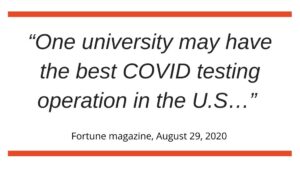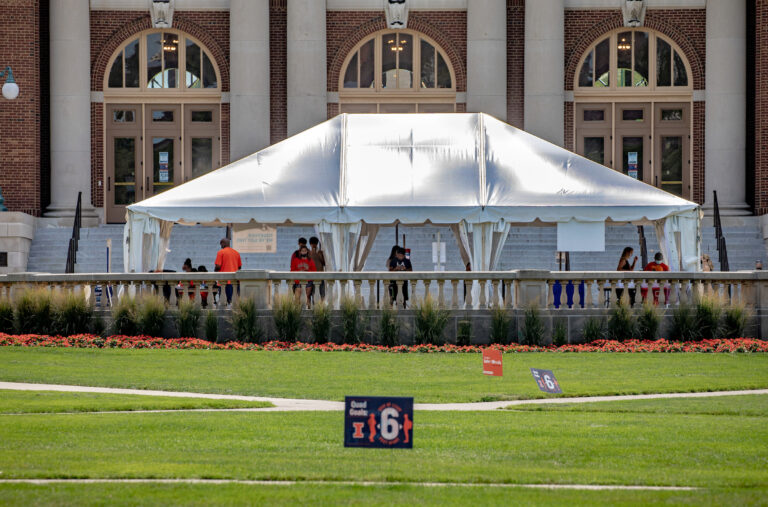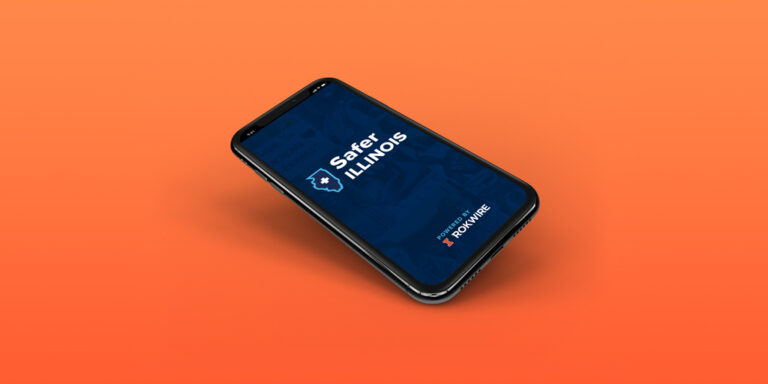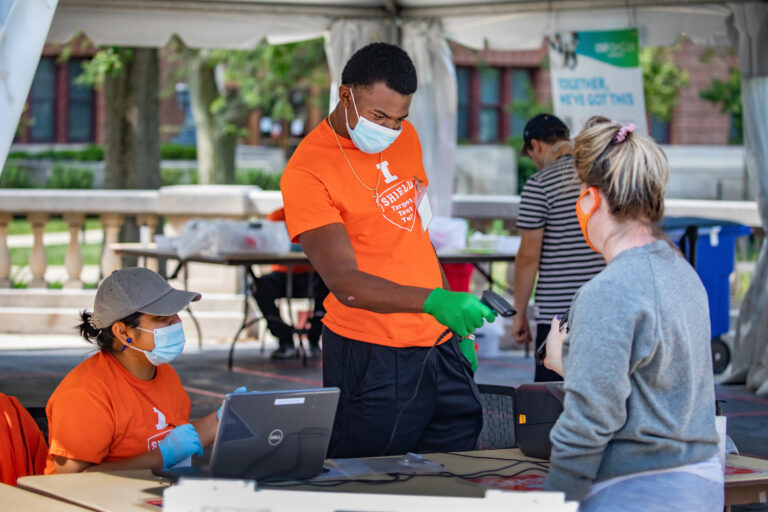When classes went fully remote due to the COVID-19 outbreak in Spring 2020, Chancellor Robert Jones knew a lot of work would be necessary to get students, faculty, and staff back to campus safely in the Fall. Technology Services at Illinois, the central IT organization for the university, has been instrumental in making that possible.

As is often the case, Technology alone is not as important as what it enables people to do. Provost Andreas Cangellaris, understanding that Technology Services houses expert staff and a proven collaborative innovation unit, called upon the organization to design and implement systems that would allow for a physical return-to-campus in the Fall of 2020. Technology Services, in partnership with many colleges and units across the university, developed the technology behind the world-recognized testing operation that supports an average of 65,000 COVID-19 tests per week.
From the time an individual swipes their i-card at a testing location to the moment they receive test results on the Safer Illinois app, Technology Services is involved in nearly every step.
COVID-19 Testing Sites

The Technology Services team at Swanlund is responsible for many components of the seventeen COVID-19 testing sites comprising 45 computer systems. On a daily basis, they are charged with software and hardware support, elements of employee training, and pieces of site support. At the outside testing sites, computers, printers, scanners, and card-swiping devices are gathered every evening and stored in a secure location, then set up the following morning.
Tech support for the hardware and software is also provided by Technology Services. While many common issues are addressed by local site leads, Technology Services staff have designed and provided the help documentation to support those leads. If there are further issues that cannot be resolved by testing site staff, the Technology Services Help Desk is the first point of contact. Incoming tickets are directed to the Help Desk where initial troubleshooting is completed. If the issue is escalated, the ticket is assigned to a specific campus IT support team, all who have volunteered their time, to be resolved. Should IT support staff not be able to resolve the issue, the Tech Services team at Swanlund serves at the final escalation team.
After the close of business hours, technical support is provided by Tech Services OnSite staff, a collection of Tech Services student employees. They assist with any technical issues that may arise from 5:30pm to 8:30am.
Systems in the Background
How does information get from the testing site to your mobile device once results are available? Secured, encrypted data is transferred from labs to McKinley Health Center which manages the secure storage of test results. For those using the Safer Illinois app, data is securely passed to secured, encrypted servers maintained by Technology Services.
Persons who have signed in to the Safer Illinois app, and given permission for test results to be sent to the app, can get their test results delivered to their device. All data transfers to McKinley Health Center, Technology Services, and your device are encrypted. Technology Services can never see the results of a test, simply that a customer has test results available to be retrieved. Test results can only be opened and viewed by the individual’s device.
The Privacy and Security team has been, and continues to be, critical in developing the guidelines and best practices for ensuring your data’s privacy as it passes across the various systems. That team also assists in security triage in the case of reported concerns.
Safer Illinois

The Safer Illinois app is a key piece in the way that the University of Illinois is addressing the COVID-19 pandemic. The app is the primary means by which students, faculty, and staff receive their test results, and allow a campus member to enter university buildings. Technology Services staff are responsible for the development, management, and implementation of the app at UIUC.
After saliva-based testing was approved as an effective test, the university had to quickly determine how to get results to the campus community. As a result, the Safer Illinois app had to be created, developed, and launched in less than two months. That’s an extremely fast timeline for an app, especially one that is simultaneously released on iOS and Android app stores. Isaac J. Galvan, the product owner of Safer Illinois, attributes that success to the collective problem solving and participation of units across the university. “NCSA has been a huge contributor to the project…They help with app management pieces and managing the back end. A very key portion of the app, the exposure notification system, was developed by professors and students out of the college of ECE (Electrical and Computer Engineering). That was a huge contribution to the app that was developed at Illinois.”
The team continues to consider and update the app based upon feedback from the community. The most recent release includes some key new features. “One of the things that is a quality of life feature…say you got tested last week Thursday, and you know you have so many days to get tested again, you used to have to do the mental gymnastics and count on your fingers to figure it out. The next release clearly tells you when you need to have a negative test by this date to maintain your building access status.”, states Galvan. The latest release also integrates testing site wait times.
The Tech Services Help Desk and Communications and Marketing team aid the Safer Illinois app team with front-end customer support such as creating and maintaining KnowledgeBase articles, socializing the app, and supporting the Safer Illinois app website.
The Technology Loan Program

Amazing systems and tools can be developed, but they’re not valuable unless people can use them. At times there are gaps between developed technologies and the devices that people have to run them.
Technology Services has been involved in ensuring that faculty, students, and staff have the tools needed to continue being successful. In the Spring of 2019, when COVID-19 forced everyone to teach, learn, and work from home, Tech Services started the Tech Loan Program. The Tech Loan Program Overview KnowledgeBase article states, “The Technology Loan Program is a partnership established across the campus IT community to loan technology hardware to eligible students, faculty, and staff who have unmet needs. This includes the loaning of computers and internet hotspot technologies to support online learning and work-from-home activities for the duration of the Covid-19 crisis.”
Over time the Tech Loan Program expanded to include loaning microphones for individuals teaching on campus so that faculty and graduate students wouldn’t be sharing microphones that are placed close to a person’s mouth.
When the Safer Illinois App was launched, Tech Services knew that there would be individuals who didn’t have a device that could run the app. In response, Technology Services purchased 1,000 iPhone SEs to loan to faculty, students and staff. These devices provide unlimited data plans but are locked down to University-related websites and services as well as a locked App Store.
To date over 1,000 laptops, tablets, webcams, and smartphones have been loaned to the campus community. Requests for equipment can be submitted by completing a form available in the KnowledgeBase .
Fulfilling Our Mission
Technology Services prides itself in the service and support of the University. Our mission is to connect people and technology to help Illinois and our partners thrive. The organization has provided support throughout the COVID-19 response and the return-to-campus efforts. We continue to be a visible, engaged community of IT professionals shaping the future of the University through technology.